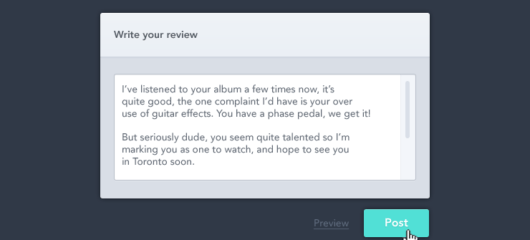
How Intercom got our first customers
Main illustration: Roman Muradov
There are two harsh truths for startups. 1: Until you have users, you don’t have a product. 2: Until they’re paying you, you don’t have a business.
So where do users come from? That is literally the number one question I get on every podcast, every fireside chat, every Q&A, live blog, AMA, you name it. Like all such questions, the real asks are behind the scenes. “How can I get mine?” “Will your method work for me?”
So I thought I’d answer it properly and consistently for once. TL;DR: I emailed people and asked them to try our product. End of Post.
In 2011 we were just four folks with a lump of code and a shared idea. Collectively we called the whole thing Intercom. The idea was to make internet business personal. Where did that come from you ask?
A quick bit of background…
We hated the siloed mess of tools that were out there – we had run our previous company using them. There was one tool when you wanted to message your customers. There was a different tool when your customers wanted to message you. There was a different one again if you wanted to ask a question. And a different one if you wanted to send a product update. There was a tool for seeing how many people were doing things on your site. Or in your product. But there was literally no tool to show you who was doing what.
Yes, you could have your engineers spend their hours writing heaps of middleware to connect your Google Analytics to your janky PayPal dashboard (there was no Stripe back then), to your newsletter software, through to your helpdesk software. But most businesses wisely believe their engineers should be building their product, not messing around daisy-chaining incomplete APIs together.
Intercom could do things like “Put a message live for all your users to see”



Intercom customer acquisition strategy 0.01 beta
With the benefit of hindsight (and having spent 2+ years on Intercom’s marketing team), it’s easy to retrofit logic here and say that I had a strategy and that it was my plan to:
a) Acquire customers through content marketing.
b) Send direct outbound email to customers.
c) Create brand awareness through off-site content campaigns.
But honestly at the time it was a lot simpler. It was basically “Do things that make people find out about Intercom”. Our previous businesses had helped us grow a network of people who would listen to us, so they were the first people we reached out to.
So all day every day I’d email people to tell them about Intercom, show them what Intercom might look like for them, and hear their feedback. I did this 100% by hand and if I was to do it all again today I’d still do it by hand. Honestly.
This is what it looked like.

But Des, you could have used “AutoMail” or “ProspectDawg” or “OutboundMaster2017 (Enterprise Edition 7)”. First of all they were all still in alpha back then, but secondly and more importantly, it’s not the right time to do this.
The reasons I think doing it by hand was the right call include:
- The approximately 100 or so emails I sent every day built on the previous day’s learnings. When you’ve read the 40 replies and understood common confusions, you can address them in the following day’s new set of emails.
- Every email was pretty much unique, which meant that the automatable boilerplate was minimal.
- Doing it by hand helped me avoid all the tell-tale signs of a bad outbound campaign. I wasn’t guessing email addresses. I wasn’t sending the same email to someone’s personal and professional address. I’d include every contact in a company on the same mail rather than send them three identical emails.
- I was creating custom screenshots of example use cases for their exact businesses, and speaking their exact languages. I was showing them something they definitely wanted.
- (Warning: fluffy point ahead.) There is just something primal about trying to sell your software directly to people and listening to what they say. When your runway is measured in weeks and you’re spending your own savings, every rejection is like a dagger to the soul, and every positive reply warms your heart. I think those emotions are good to taste, and I honestly worry about early stage founders who see themselves as above this type of graft, or think that they should API their way out of it.
All automation loses nuance and nuance is literally all you have in the early days, so embrace it. You could call this a “Nail it before you scale it” strategy, but then we wouldn’t be friends because I can’t stand things like that.
“There will be webinars”
We opened up Intercom to the public on January 27th, 2011 and with the floodgates open I decided to switch to blogging and presenting webinars to help onboard groups of users at a time. Again, there were ways to automate this and avoid the hard work, at a cost of the nuance. So every week I did one live webinar on Wednesday nights to groups ranging from 9 to 90 depending on how successful the week had been. My goal was to get 100% of the attendees using the product and some weeks we got damn close.
Perhaps the biggest high/low from this period was when I got a mail from some startups folks in India wondering if I could send them a recording of the video (as the timezones didn’t overlap) and I was tempted to do just that. But that’s not how you win customers. So one morning I got up at 4am and drove to work to give a webinar to nine folks in India thinking if I could just get one of their companies to sign up it’d be worth it.
I’m up at 6am to run a seminar for good folks in Australia, New Zealand, India, Singapore and more. Starting now: https://t.co/GAVLVk7z
— Des Traynor (@destraynor) August 2, 2012
In the end they all signed up and I went back to bed. Job done. Today our webinars and demos have grown up massively and are something to be admired, but don’t confuse where we are today with where you start.
There’s no magic bullet
So whilst I know most people are looking for our “one top tip” or the magical “hack” that got us customers, there really isn’t any one thing. We grew email by email, Skype by Skype, webinar by webinar, and looking back I can’t distill it down to any one thing. Just do all of it and one of two things will happen: either it starts working eventually, or you just can’t do it anymore. If it doesn’t work out, you’ll feel a lot better knowing that you gave it everything you had, rather than realising you should have actually talked to your would-be customers before trying to automate them.
If you think this is just 1,200 words to say what Paul Graham has been saying for years – “Build stuff and talk to users” – you’re mostly right. (He didn’t cover webinars though :-) ) But maybe the depth here might make it stick.
In any case, hope it helps. What’s your next question?





